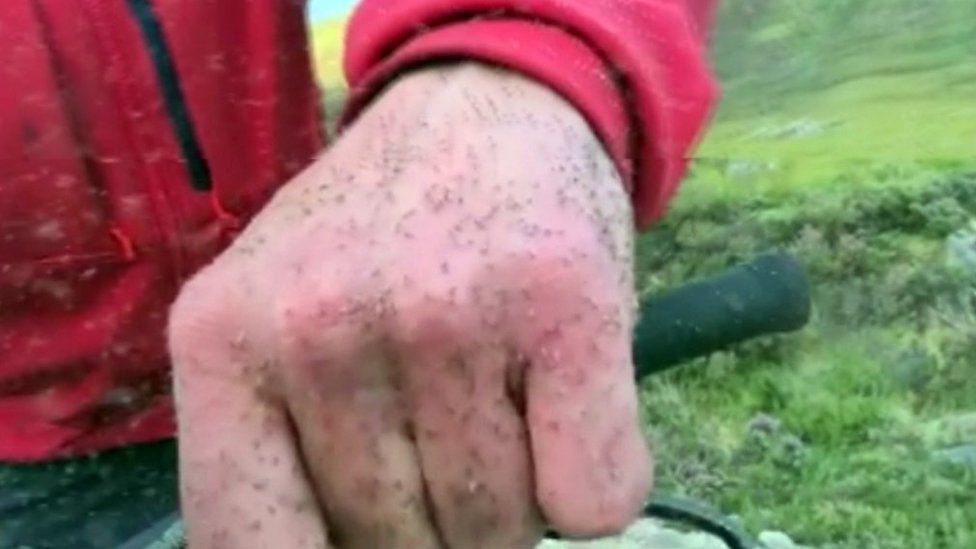
Midges can be the scourge of outdoor pursuits enthusiasts during Scotland’s summer
By Georgina Davies
BBC Scotland News
Scotland’s midge population could soon be unusually high due to recent weather patterns, according to experts.
The Scottish Midge Forecast said the insects hatched within a shorter timeframe this year because of a cold spring followed by a warm spell.
Dr Alison Blackwell said this resulted in a large first hatching with smaller geographical variations.
She said if it remained damp or humid she would expect a “mega second generation” to start hatching.
The tiny biting insects thrive in wet and warm conditions and usually have two hatchings during the Scottish summer.
Last year dry conditions made life difficult for the midges, but Dr Blackwell said there had been sufficient humidity this year to help them survive.
“Now we’ve got a big starting population, it means that the levels will stay quite high now throughout the summer probably, unless there’s a really dry heatwave,” explained Dr Blackwell, who runs the forecast.
“At the minute it’s quite humid which is perfect for them.”
Image source, The Scottish Midge Forecast/Google
Milder west coast winters mean that more larvae survive than in the east of the country
The coming week looks set to be wetter which, if it continues, could provide the ideal conditions for the second hatching.
Midges usually spend the winter in the soil as larvae until the days get longer and warmer in the spring, which initiates them turning into adults.
Dr Blackwell added: “We would normally expect the first peak of adults in the last week of May, first week of June.
“That appears to have been delayed because of the colder weather we had at the beginning and middle of May.”
Midges normally first appear in the south of Scotland and then later in the north west based on weather patterns.
The recent warm weather has resulted in a “synchronous hatch” where the midges hatched within a shorter timeframe.
“The ones emerging now will lay eggs and then in six weeks’ time we will have a second emergence,” Dr Blackwell said.
“How big that second peak is, depends on the first generation of midges and how many batches of eggs have been lain.
“If it becomes damp, I think we’ll have a mega second generation probably because we’ve got so many first generation adults out just now.”
Best in the west for midges
The Scottish Midge Forecast usually finds there are higher number of midges on the west coast of Scotland.
Dr Blackwell said this was because the insects breed in damp, peaty soil which naturally occurs in the western half of the country.
She added: “It also tends to be a bit milder as well which is better for their activity.
“The winters are less cold usually than the east coast so you get a greater survival rate of the overwinter larvae as well.”
Image source, APSBiocontrol
The midge forecast collects data from traps that attract the insects
Dr Blackwell, director of APS Biocontrol in Dundee which runs the Scottish Midge Forecast, said midge numbers were predicted through modelling and some live data.
“We have a series of midge traps across Scotland and people collect data for us,” she said.
“We also model populations based on years of population data and weather data so that our forecast is primarily driven by a set of algorithms.”
Midges do not transfer any dangerous diseases to humans so the work of the forecast is mostly to predict “peak nuisance levels”.
They can transmit some diseases to sheep and cattle, although it is uncommon in the UK because midges die out over winter.
“In the past we have had infected midges blowing to the UK from mainland Europe carrying diseases like bluetongue virus,” said Dr Blackwell.
“Back in 2007, we had the last bluetongue invasion to Scotland and the UK. It was important then to be able to map where midges were so that the livestock industry could be aware of that too.”
What is the point of midges?
For most of us, midges are an frustrating and inconvenient part of a Scottish summer, so why do they exist?
Dr Blackwell said they are an important part of the natural ecosystem.
“The larvae, the juvenile stages are probably most important because they’re like mini earthworms,” she said.
“They live off decaying plant matter and stuff so they’ll be part of that whole food chain, decomposing plant matter back into carbon sources.”
She added that the adult midges also formed part of the diet of small birds and bats.








